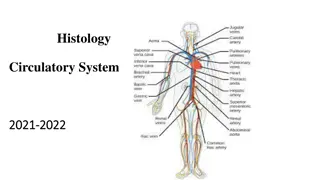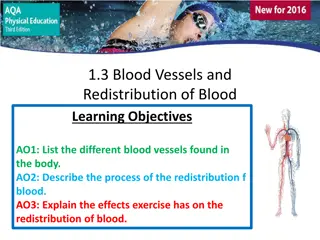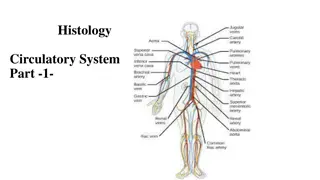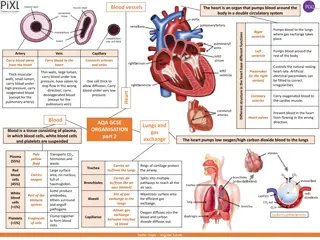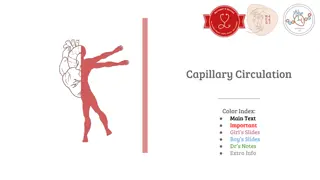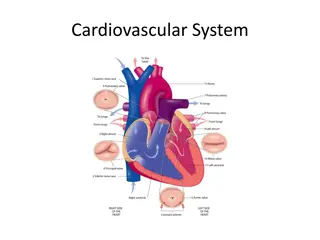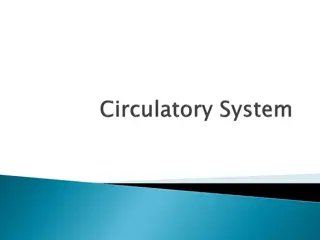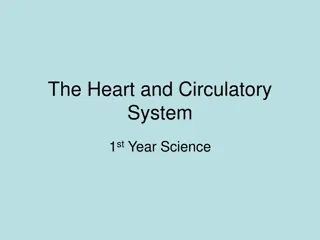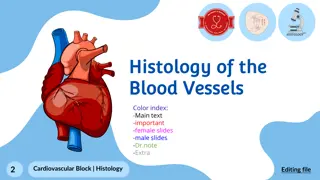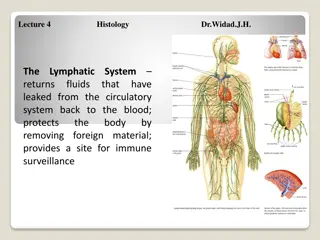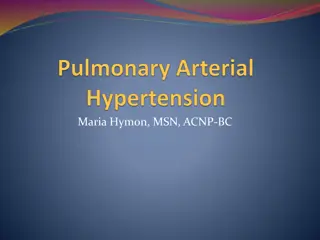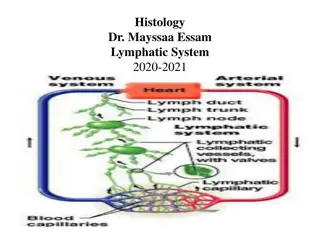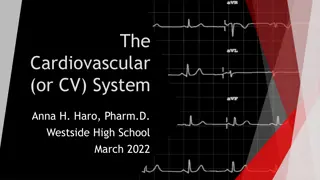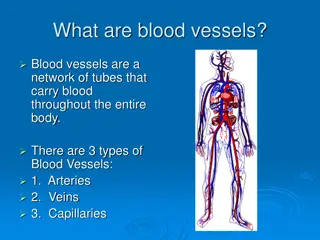Understanding Pulmonary Circulation and Its Importance in Respiratory Physiology
Pulmonary circulation, as explained by Professor Narsingh Verma, plays a crucial role in the respiratory system, showcasing distinct differences from systemic circulation. The low pressure and resistance in pulmonary circulation allow for optimal gas exchange at the alveolocapillary membrane. Variou
1 views • 30 slides
Understanding the Circulatory System in Animals and Plants
Transportation in animals and plants involves the movement of food, water, gases, and waste products through a circulatory system. Blood, a vital fluid connective tissue, carries out these functions by transporting essential substances like oxygen, nutrients, and waste products. The circulatory syst
0 views • 14 slides
Understanding the Circulatory System: A Detailed Overview
The circulatory system plays a vital role in transporting nutrients, oxygen, and other essential substances throughout the body. It consists of the blood vascular system (arteries, arterioles, veins, capillaries, and the heart) and the lymphatic vascular system. Understanding the general structure o
0 views • 31 slides
Understanding Blood Vessels and Circulation in the Body
Explore the intricate network of blood vessels in the body, including arteries, veins, and capillaries. Learn about the process of blood redistribution and the impact of exercise on circulation. Understand the vital role of the circulatory system in maintaining overall health and physical performanc
0 views • 14 slides
Understanding the Human Gas Exchange System
Explore the essential organs involved in the human gas exchange system, discussing their functions and the importance of efficient gas exchange in organisms. Dive into the process of breathing, gas exchange, and the role of key structures like alveoli and capillaries. Engage in self-assessment tasks
2 views • 18 slides
Understanding Repair by Connective Tissue in Healing Processes
Healing or repair by connective tissue occurs in response to severe or chronic tissue injuries, leading to the replacement of nonregenerated cells with connective tissue or scar formation. This process involves the induction of fibroblast and endothelial cell proliferation, granulation tissue format
3 views • 26 slides
Understanding the Circulatory System and Blood Vessels in Histology
The circulatory system, comprising the cardiovascular and lymphatic systems, plays a vital role in transporting essential substances throughout the body. It consists of arteries, veins, capillaries, and the heart. Blood vessels have distinct histological structures with three main layers - intima, m
1 views • 15 slides
Exploring the Components of the Circulatory System
The circulatory system, comprising the heart, blood vessels, and various components like arteries, veins, and capillaries, plays a crucial role in distributing oxygen, nutrients, and waste products throughout the body. The heart pumps blood through a double circulatory system, ensuring oxygenation o
0 views • 4 slides
Understanding Capillary Circulation in the Vascular System
This content delves into the intricate components of capillary circulation, covering topics such as microcirculation, types of capillaries, regulation of flow in capillary beds, and the formation of interstitial fluid. It also discusses edema, lymphatics, diffusion, and filtration processes. The vis
4 views • 28 slides
Outer Tracker Cooling Pipework Update at CERN
This update at CERN covers various tests and operations related to the cooling pipework of the outer tracker. It includes pressure drop tests, soldering, vacuum-brazing tests, and preheater operation tests. The setup involves tubes of different internal diameters connected to a measurement setup to
2 views • 29 slides
Understanding the Cardiovascular System: An Overview
The cardiovascular system, comprising the heart and blood vessels, plays a vital role in delivering oxygen and nutrients to body tissues. Arteries carry oxygenated blood away from the heart, veins transport deoxygenated blood back to the heart, and capillaries facilitate nutrient exchange. Learn abo
0 views • 21 slides
Understanding the Microscopic Structure and Function of the Pituitary Gland
Explore the detailed histology of the pituitary gland, focusing on its adenohypophysis and neurohypophysis components. Learn about the diverse parenchymal cells, including acidophils, basophils, and chromophobes, and their respective functions in hormone production. Dive into the significance of the
0 views • 6 slides
Understanding the Circulatory System: Functions and Components
The circulatory system, comprised of pulmonary and systemic circulation, plays a crucial role in transporting oxygen, nutrients, and waste products throughout the body. It consists of the heart, arteries, veins, and capillaries which work together to ensure proper circulation. Blood, the carrier of
0 views • 21 slides
Overview of the Cardiovascular System and Arterial Blood Vessels
The cardiovascular system includes the heart, arteries, veins, and capillaries, responsible for the transport of blood and lymph throughout the body. Arterial blood vessels are classified based on diameter into large (elastic) arteries, medium (muscular) arteries, and arterioles. The arterial wall c
0 views • 13 slides
Understanding the Heart and Circulatory System in Science
Explore the key concepts of the heart and circulatory system, including the functions of arteries, veins, and capillaries. Learn about how the heart pumps oxygenated and deoxygenated blood, the role of valves, and the circulation process. Dive into engaging animations and resources to enhance your u
0 views • 6 slides
Understanding the Cardiovascular System: An Overview
The cardiovascular system, comprised of the heart, blood vessels, and blood, plays a vital role in circulating nutrients, oxygen, and waste throughout the body. This summary provides insights into the structure and function of the heart's chambers, blood flow through the circulatory system, and the
0 views • 17 slides
Experimental Analysis of Capillary Diameter in Paper and Textile Fabric
Conducted by a team named RFMS, the experiment aimed to estimate the diameter of capillaries in paper and textile fabric through experimental methods. The theory analysis lacked clarity, but the experiment was well-structured, exploring the effects of temperature and density on capillary behavior. T
0 views • 7 slides
Microscopic Structure of Blood Vessels and Their Layers
The lecture covers the microscopic structure of the wall of blood vessels including large veins, elastic arteries, muscular arteries, and blood capillaries. The three concentric layers of blood vessel walls are discussed, which include the tunica intima, tunica media, and tunica adventitia. Detailed
0 views • 11 slides
Overview of the Lymphatic System and Immune Response
The lymphatic system plays a crucial role in returning leaked fluids back to the blood, protecting the body from foreign materials, and supporting immune surveillance. It consists of lymphoid cells such as T and B lymphocytes, macrophages, dendritic cells, and reticular cells that work together to d
0 views • 31 slides
Understanding Pulmonary Arterial Hypertension (PAH): Causes, Symptoms, and Management
Pulmonary Arterial Hypertension (PAH) is a progressive disease characterized by increased blood pressure in the pulmonary artery, veins, or capillaries. This condition can lead to right ventricular failure and eventual death if left untreated. PAH can have various causes, including idiopathic factor
0 views • 49 slides
Understanding the Lymphatic System: An Overview of Lymph Vessels and Functions
The lymphatic system plays crucial roles in maintaining fluid balance, immune response, and waste removal in the body. Comprised of lymphatic vessels and organs, this interconnected system transports lymph fluid from tissues back to the bloodstream. Lymph capillaries, lymph nodes, and larger collect
0 views • 22 slides
Understanding the Cardiovascular System: Anatomy, Physiology, and Function
Explore the intricate workings of the cardiovascular system, encompassing the heart, blood vessels, and blood circulation. Learn the anatomy, physiology, and function of this vital system, including the roles of arteries, veins, capillaries, and red and blue blood. Understand how the cardiovascular
0 views • 23 slides
Understanding Blood Vessels and Their Role in the Body
Blood vessels are a crucial part of the circulatory system, comprising arteries, veins, and capillaries. Arteries carry oxygenated blood away from the heart, veins transport deoxygenated blood back to the heart with the help of valves, and capillaries act as connectors between arteries and veins, fa
0 views • 5 slides
Understanding Hemangiopericytoma: Symptoms, Diagnosis, and Treatment
Hemangiopericytoma is a rare soft tissue tumor originating from pericytes in capillaries. Learn about its symptoms, diagnosis methods, treatment options, and the role of pathology and IHC. Follow-up care, adrenal tumor functionality, and potential associations with MEN syndrome are also discussed.
0 views • 36 slides


